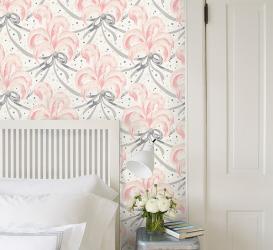In the realm of interior design, where trends come and go, some motifs endure as perennial classics. Among these enduring symbols of beauty and refinement, the ribbon and bow motifs have gracefully woven their way into the very fabric of interior design. Whether adorning furnishings, wallcoverings or decorative accessories, these intricate designs have a history rich in symbolism and a timeless allure that continues to captivate homeowners and designers alike.
The use of ribbons and bows in interior design can be traced back to ancient civilizations. In ancient Greece, the knot of Heracles, a precursor to the modern bow, symbolized strength and unity. Similarly, in ancient Rome, decorative bows adorned furnishings and textiles as symbols of prestige and opulence. These motifs transcended time and culture, finding their way into various design styles throughout history.
The 18th century distinct influence on furniture was the famous furniture designer, Thomas Chippendale. His French style with extravagant, carved details led to the rework of the Queen Anne style chair, to incorporate pierced back splats and an array of ribbon motifs and scrolls. The ribband-back chair was one of the most expensive and exquisitely carved pieces of the time.
The 19th century Victorian era is renowned for its ornate and opulent design aesthetic. Often seen in drapery, upholstery and furniture, ribbons and bows exuded femininity, grace and romance. As the 19th century gave way to the 20th century, interior design evolved, giving rise to the Art Nouveau and Art Deco movements. Ribbons and bows continued to feature prominently, but with a modern twist.
Today, the ribbon and bow motifs have made a resounding comeback in interior design. Their timeless elegance appeals to both traditionalists and modernists, providing a versatile means of adding a touch of refinement to any space. From delicate ribbon-trimmed throw pillows to bold, oversized bow-patterned wallcoverings, these motifs have transcended their historical roots to become a staple of contemporary design.
Designers are finding innovative ways to incorporate ribbons and bows into modern interior design. In minimalist spaces, a single ribbon-accented piece can serve as a focal point, creating a striking contrast to the clean lines and neutral palette. In maximalist settings, layering multiple elements, such as bow-patterned wallpapers, bow-tied curtains and ribbon-adorned furniture, adds a sense of opulence and drama.
The enduring allure of ribbons and bows in interior design products and furnishings lies not only in their aesthetic appeal but also in their rich history and symbolism. From the extravagance of the Victorian era to the sleekness of Art Deco and the contemporary revival, these motifs continue to capture the imagination of designers and homeowners alike. As they continue to evolve, ribbons and bows remain a symbol of timeless elegance in the ever-changing world of interior design, proving that some design elements are truly ageless.





